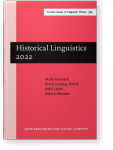Patterns of suppletion in inflection revisited
What the Crossover Constraint constrains
Examining the distribution of suppletive stems over inflectional paradigms, a constraint on their
complexity, call it Crossover Constraint, is shown to be untenable. There are paradigms, in some languages at some stage of
their development, where suppletive distributions are maximally complex — like one stem of a verb being used for 1st Person
Singular and 3rd Person Plural and another stem for all other person and number forms, which in terms of paradigm geometry is
a crossover distribution. Rather than unceremoniously dumping this universal it is argued that constraints on states must be
distinguished from constraints on transitions. There are two main routes to suppletion, the harnessing of distinct stems for
one lexeme and the phonological separation of once unitary stems; their respective results are synchronically
indistinguishable. When stems are combined, they will divide up paradigms in ways that follow morphological patterns, which
outlaws crossovers, while phonological differentiations are under no obligation to respect morphological groundplans.
Article outline
- 1.Unruly suppletion?
- 2.The Crossover Constraint
- 3.Paradigm geometry of suppletion
- 4.What are universals supposed to be true of?
- 5.Dual route, one destination
- 6.Not to forget gaps
-
Notes
-
References
This content is being prepared for publication; it may be subject to changes.
